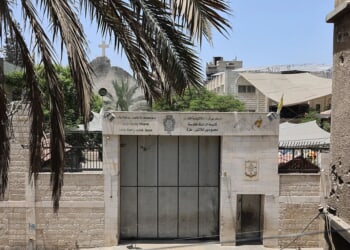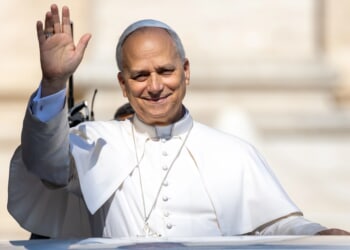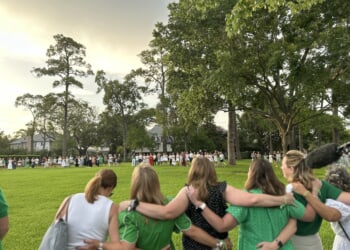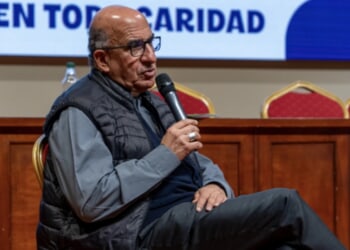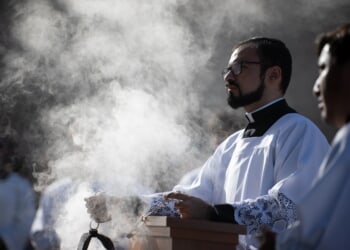And as moths swiftly rushing enter a burning flame and die,
so all these men rush to thy fire,
rush fast to their own destruction.
The flames of thy mouth devour all the worlds.
Thy glory fills the whole universe.
But how terrible thy splendours burn!
— The Bhagavad Gita, 11.29-30
I
Every religion has its explanation for the fallen state of man, the eternal folly of mankind, and the prevailing filthiness of human nature — Pandora’s Box, original sin, the evil inclinations of yetzer hara, the malign influences of the lower nafs, the suffering caused by a state of ignorant avidyā, the harmful effects of body thetans, among others — but we all seem to agree that humanity was born in a garden, and promptly turned our earthly home into a bear-garden.
How fitting it is that arguably the oldest historiographical document of all, the Stele of the Vultures in the Louvre Museum (2475 B.C.), celebrates the victory of the Mesopotamian city-state of Lagash over the neighboring Umma, depicting on its surface a “multitude of corpses,” heaped up to “reach the base of heaven.” History begins, quite literally, with a massacre. On the limestone stele we find the victorious soldiers of Lagash trampling their dead enemies, as carrion birds swoop down to feast on dangling entrails exposed by copper spearpoints, battle knives, and arrows, while the founder of the First Dynasty of Lagash boasts: “I, Eannatum, like a fierce storm wind, I unleashed the tempest!” He sowed the wind, and still we reap the whirlwind.
[W]hen we think of Preah Vihear, instead of thinking of the destruction that has … been carried out in its name, we should think of the sheer beauty of the … incomparable architecture and artworks secreted therein.
Yet another account of the origins of our innate predisposition towards violence and conquest can be found in the Rig Veda, which tells of Māthava, the first king of Videha, who held captive, in the cavity of his own mouth, the fire-god Agni Vaisvânara. Although fire was considered essential for everything from digestion and burning love to holy sacrifice and divine creation, Māthava was wary of Agni’s destructive potential, and year after year the king kept his silence, mute for fear of the consequences of the deity’s escape (uncomfortable though the arrangement must have been).
Yet the Rishi Gotama Râhûgana, Māthava’s family priest and a great sage, presumed to know better, and plotted to lure out the fire-god for the sake of the sun and the hearth. First, the holy man prayed: “Upwards, O Agni, dart thy brilliant, shining rays, thy flames, thy beams.” Agni did not answer, and the king’s lips remained sealed. Another attempt was made by the seer, who tempted the god with the tantalizing promise of sacrifice. “Thee, O butter-sprinkled one, we invoke,” intoned Gotama Râhûgana, and this time Agni flashed forth from the king’s mouth.
The Italian writer and Sanskrit scholar Roberto Calasso described the dramatic consequences of the god’s escape in his magisterial 2014 meditation on Indian philosophy, Ardor: “from the moment Agni fell down to earth, he began to burn it. King Māthava found himself at that moment by the Sarasvatī River. Agni then began to burn the land eastward. It marked out a path — and the king and the brahmin followed it.” In this startling and unpropitious fashion did human history commence, according to the Vedas, for as Calasso concluded,
The first act of history is therefore not that of the ruler, of the kṣatriya, of the warrior. It is an act of the brahmin, of he who kindles every event, who compels the fire to leave its refuge. What immediately follows is a brief outline of what would always happen thereafter: man follows the path left by fire, which goes before him, scorching the land. This is civilization, before all else: a trail marked by flames. And in the euphoria of conquest there is no need to think that desire or human greed take over. Men always follow: it is Agni who conquers.
The hymns of the Rig Veda are full of praise for conquering Agni, god of fire, god of lightning, god of the sun, the god of the priests, and the priest of the gods:
Infallible is Agni, he who goes before the tribes of men,
A chariot swift and ever new.
Strength of the Gods which none may harm, subduing all his enemies,
Agni is mightiest in fame.
By offering sacred food to him the mortal worshipper obtains.
A home from him whose light makes pure.
From Agni, by our hymns, may we gain all things that bring happiness,
Singers of him who knows all life.
O Agni, in our deeds of might may we obtain all precious things:
The Gods are centered all in thee.
Yet the quest to obtain “all precious things” so often goes awry, when construed in a narrowly acquisitive sense. Krishna, the eighth avatar of Vishnu who served as the archer Arjuna’s divine charioteer in the Bhagavad Gita, praises above all those who are beyond desire, for whom “gold or stones or earth are one,” and assures us that “He who offers me with devotion only a leaf, or a flower, or a fruit, or even a little water, this I accept from that yearning soul, because with a pure heart it was offered with love.” As a species, however, we seldom go in for quietism, preferring to follow Agni’s trail of conquest and destruction. Such is human nature.
II
The ruins of the ancient Hindu Temple of Preah Vihear sit atop the escarpment of Poy Tadi, deep in the Dângrêk Mountains of Cambodia’s Preah Vihear province, near the contested border with Thailand. “To sit on Preah Vihear’s rocky outcrop as dawn’s red glow turns to silver,” wrote the French journalist Thierry Cruvellier, “is to witness the majestic morning of the world as it was before man, and as it remains despite him.”
It was through these mountains, in 1975, that tens of thousands of refugees fled from Pol Pot’s advancing Khmer Rouge communist guerrillas. It was in these mountains that, to again borrow the words of Roberto Calasso, “grave diggers heaped piles of skulls into the forms that Cambodian peasants had used from time immemorial to stack their annual pineapple harvest. In the face of mass graves, history returns to being natural history.” And it was in these mountains that Pol Pot made his last stand, near the small town of Anlong Ven, before his heart failed and he was unceremoniously cremated in a pile of rubber tires and assorted household rubbish.
It is possible to undertake a grim sort of pilgrimage to the ramshackle grave of Pol Pot, recently covered by a coffin-shaped acrylic roof designed by two young Cambodian architects, Meas Makara and Chhoeun Vannet, but a far more impressive and worthwhile monument lies elsewhere in the Dângrêk Mountains — that of crumbling Preah Vihear. Built with great slabs of gray and yellow sandstone by the kings of the Khmer Empire beginning in 893 ad, and greatly enlarged over the course of the 11th and 12th centuries, the temple occupied “the most remarkable site of any large temple of Indo-China,” according to the diplomat and historian Lawrence Briggs.
Unlike the vast complex of Angkor Wat, Preah Vihear is laid out in a linear fashion, stretching some 800 meters up the slopes via stairs, causeways, and gopura gateways towards a final shrine perched precariously on the very edge of the Dângrêk plateau. And while Angkor Wat was dedicated to Vishnu, the god of preservation, Preah Vihear was consecrated to Shiva, the god of Destruction, who in his capacity as the Cosmic Dancer is usually depicted gamboling within the prabha mandala, a great arch of flames that creates all and consumes all, while he wields, in one of his four hands, Agni himself. There are further connections between Shiva and Agni, with the former frequently appearing as cosmic pillar of fire, and able to produce Krodhagni, the “fire of wrath,” from his third eye; the medieval Rudrahridaya Upanishad suggests that Shiva and Agni are simply one and the same.
At Preah Vihear, on the southern doorjamb on the western door of Gallery H, is an inscription in Old Khmer and Sanskrit:
bhūlokedyājavedyāś śubhatalanihitaṁ saptalokāntarūḍhan
dānāmbhonityasiktaśrutavahalaphalānanditasvarggivarggam(·)
kīrttisvarvāsivr̥kṣan dadhad adhikaguṇacchāyayācchāditāśaṁ
rājā śrīsūryyavarmmāvudhibhujavivarair āpa sadrājyalakṣmīm(·)Celui dont la gloire, tel l’arbre céleste planté aujourd’hui sur la terre, est placée sur la surface pure de l’autel d’Agni, pousse aux confins des sept mondes, réjouit la foule des habitants du Ciel par ses fruits nombreux et renommés, sans cesse arrosés par l’eau de ses donations, et couvre les points cardinaux de l’ombre de ses éminentes vertus, le roi Śrī Sūryavarman a obtenu l’excellente royauté [en l’année marquée] par les [9] ouvertures, les [2] bras et les [4] océans. (Tr. George Cœdès, in Inscriptions du Cambodge, volume VI. Collection de textes et documents sur l’Indochine 3.6. Hanoi, Paris: École française d’Extrême-Orient, 1954, pp. 255–257.)
He whose glory, like the celestial tree planted today on earth, is placed on the pure surface of the altar of Agni, grows on the confines of the seven worlds, gladdens the multitude of the inhabitants of Heaven by his numerous and renowned fruits, constantly watered by the flow of his donations, and covers the cardinal points with the shade of his eminent virtues, King Śrī Sūryavarman has obtained the excellent kingship [in the year marked] by the [9] openings, the [2] arms and the [4] oceans [1002 ad].
By the 14th century, the Khmer royal family had converted to Theravada Buddhism, and Hinduism gradually declined throughout the region. The Shivaite sanctuary of Preah Vihear, with its blazing Altar of Agni, was no longer fed by a steady flow of royal donations and sacrificial offerings. Occasionally Buddhist monks from a nearby monastery would conduct rites in the ruins of the old temple, but otherwise the temple was gradually reclaimed by the primeval deciduous dipterocarp forests of the Dângrêk Mountains. But Shiva, the God of Destruction, the God of Time, the blazing Cosmic Dancer, would not relinquish his hold on Preah Vihear so easily, while Agni, “rich in wealth with flame most scorching,” remained a constant presence along the border between Cambodia and Thailand.
III
There is a rich, dark vein of irony to be mined from the fact that the long-simmering border conflict between the Kingdom of Cambodia and the Kingdom of Thailand should be focused on a temple dedicated to the god of Destruction. While the present tensions between the two countries can be attributed to a personal rivalry between Cambodia’s senior leader Hun Sen and Thailand’s Prime Minister Paetongtarn Shinawatra, or to geopolitical friction between the United States and China (the former backing Thailand, the latter a closer partner with Cambodia), ultimately the deadly border clashes of late July, 2025 are the product of contested histories as tangled as the undergrowth in the dry forests of Preah Vihear, a place where history and natural history are coalesced.
The trouble began with the Franco-Siamese Treaty of 1907, ratified by the Third French Republic and the Thai Rattanakosin Kingdom, which resulted in the loss Siamese control over certain regions in Inner Cambodia, including Siem Reap, Battambang, and Sisophon (now the second, third, and fourth most populous cities in Cambodia, so hardly a matter of minor importance).
But when the French officers Tixier, Kerler, and de Batz visited the Siamese-French Indochinese borderlands, later to become the Thai-Cambodian borderlands, the line of demarcation they drew deviated slightly from the Dângrêk watershed, placing the ancient Temple of Preah Vihear on the French side of the border. The last time the Siamese had tangled with the French colonial forces, during the Franco-Siamese crisis of 1893, Bangkok had lost control of all of Laos, so protests over the controversial border were relatively muted, and understandably so.
And then it was in the year 1930 that the Siamese Prince Damrong Rajanubhab, along with his three daughters and a coterie of Siamese officials, crossed the disputed border and paid a quasi-official visit to the disputed temple as part of an archaeological tour of the Dângrêk Mountains. Prince Damrong, formerly a special royal ambassador and Minister of the Interior under King Chulalongkorn, had taken an increasing interest in cultural matters, publishing widely on Thai history, archaeology, and literature, helping found the National Library and National Museum, and heading up the Royal Institute of Siam. It was with considerable interest, then, that he and his retinue approached Preah Vihear, which after all had only been rediscovered by the Siamese Prince Sanphasit and officials of the governorate of Khukhan as recently as the turn of the century.
Prince Damrong was received by the French Resident of the Cambodian province of Kompong Thom, clad in his official uniform, as well as by the French archaeologist Henri Parmentier. Significantly, a French tricolore fluttered atop a nearby flagpole. According to one his daughters, the Prince initially suggested that his French counterpart “get out of his uniform,” and later he described the uniform and the flag as “impudent” gestures, but, consummate diplomat that he was, Prince Damrong avoided a direct confrontation.
First came the toasts, and then the welcoming remarks. The French Resident expressed his admiration for the Prince’s “reputation as a sincere friend of France and her subjects and protégés” and for his academic achievements. The archaeologist Parmentier followed suit, but slipped in a reference to Preah Vihear as “another monument of our Cambodia,” prompting the Prince, in his reply, to state that he “had come to see the Temple and had nothing to do with politics.” No further reference was made to the diplomatic wrangling over the region, and the Prince’s archaeological tour proceeded without incident. Upon his return to Bangkok, Prince Damrong sent the French Resident a polite note and some souvenir photographs as a gift to mark the occasion. Little did he know how posthumously significant this modest act of courtesy would prove.
IV
Prince Damrong passed away on December 1, 1943, a day now recognized in Thailand as “Damrong Rajanupab Day,” and on the centenary of his birth, in 1962, he became the first Thai to be awarded the title of UNESCO World Outstanding Personality. But 1962 also proved to be something of an annus horribilis for the kingdom the Prince held so dear, owing to a June 15 ruling made by the International Court of Justice that was meant to end, once and for all, the Thai-Cambodian dispute over Preah Vihear.
On October 6, 1959, the newly-independent Kingdom of Cambodia had asked the ICJ for a ruling that “the Kingdom of Thailand is under an obligation to withdraw the detachments of armed forces it has stationed since 1954 in the ruins of the Temple of Preah Vihear,” and that “the territorial sovereignty over the Temple of Preah Vihear belongs to the Kingdom of Cambodia.” Thailand, for its part, insisted that “Phra Viharnis in Thai territory.”
The Cambodian claim was predicated largely on those infamous 1907 French maps charting the border between Siam and French Indochina, but the Court ignored the discrepancy between the treaty text and the border delineation, instead finding that “the Siamese authorities by their conduct acknowledged the receipt, and recognized the character, of these maps, and what they purported to represent, is shown by the action of the Minister of the Interior, Prince Damrong, in thanking the French Minister in Bangkok for the maps, and in asking him for another fifteen copies of each of them for transmission to the Siamese provincial Governors.” So the Prince had thanked the French authorities for being given copies of French maps, instead of returning them to sender, and to make matters worse, he had later visited the contested site, failed to protest the presence of the drapeau français, and even sent some souvenirs of the event to his French colonial counterpart.
Sir Frank Soskice, in his pleadings on behalf of Thailand, allowed that
No doubt he [the Prince] could have taken all sorts of ridiculous steps quite out of keeping with the triviality of the occasion. Prince Damrong, as Professor Reuter said, had a sense of humour. Professor Reuter omitted to refer to the one course which a sensible person with a sense of humor would have taken and which Prince Damrong did adopt, that is to say, to ignore what he regarded as a piece of upstart arrogance. It would not be the first time in the history of mankind that a man who held the positions of dignity which Prince Damrong had held had chosen to disregard an indiscretion on the part of a comparatively junior, swollen headed official.
But there was good sense as well as good humor in evidence during the Prince’s brief visit to the temple in 1930. A certain amount of delicacy was required since, as Prince Damrong’s daughter Princess Phun Phitsamai Disku later noted, “it was generally known at the time that we only give the French as excuse to seize more territory by protesting. Things had been like that since they came into the river Chao Phraya with their gunboats and their seizure of Chantaburi.”
A consummate diplomat who had visited the courts of England, Russia, the Ottoman Empire and widely toured Egypt, India, and Burma, the Prince understood the principle of audi, vide, tace, si vis vivere in pace, and surely would have argued in front of the Court, had he still been alive, that diplomatic silence is not the same as diplomatic assent. King Chulalongkorn, who ruled Siam from 1868 to 1910, had long been a proponent of “sacrificing a finger to save a hand,” and biting his tongue when it came to French provocations. Prince Damrong was just following suit.
It therefore came as a surprise to the Thai authorities that the International Court of Justice based its 1962 ruling for Cambodia, and against Thailand, on the Roman legal principle that qui tacit consentire videtur si loqui debuisset ac potuisset, or “he who keeps silent is held to consent if he must and can speak.”
Prince Damrong had held his tongue in the presence of the French Resident to avoid instigating a conflict, much as Māthava has sought to contain the fires of Agni within his mouth. It turned out that he should have pitched a fit. Yet instead of ending the dispute, however, the ICJ ruling exacerbated it. Thailand had been judged for its calm, deliberate, rational approach to the border conflict. It would have to be less reticent going forward. “Take the Temple, remove it, but not a single grain of Thai earth must be taken away,” thundered the editors of the Bangkok Post in the aftermath of the ruling. The Thai tricolor flag that flew on the temple grounds was never lowered, but removed pole and all, and placed in a museum across the newly-determined border. “One day,” promised Minister of the Interior Praphas Charusathien, “we will be putting this flag back to fly over Preah Vihear again.”
V
Bilateral relations between Thailand and the Kingdom of Cambodia suffered greatly as a consequence of the controversial ICJ ruling, to the point where some 300 border clashes in 1966 produced 320 casualties, and an April 1966 incursion by Thai forces reached the Cambodian outpost that guarded the temple. The camp was burnt, landmines were strewn about, and tempers continued to run hot even after the Thai forces were thrown back by their Royal Cambodian adversaries. Four years later, Thai aircraft were bombing Cambodian targets in the temple vicinity. As Prime Minister Sarit Thanarat maintained,
I know full well that the loss of Phra Viharn is a loss which afflicts the entire Thai nation. Therefore, even though Cambodia may have Phra Viharn, only the ruins and the piece of land on which the Temple is situated will be theirs. The soul of the Temple of Phra Viharn remains forever with Thailand. The Thai people will always remember that the Temple of Phra Viharn was robbed from us by the trickery of those who disregard honour and justice.
As Thailand behaves in the world society as a member imbued with the highest sense of honour and morality, sooner or later the Temple of Phra Viharn shall revert once again to Thailand….The incident of Phra Viharn will remain in the memory of the Thai people for generations to come and will leave an indelible mark on the nation’s history as if it was a wound in the heart of each and everyone in the entire nation.
Or, as Rudyard Kipling once wrote, “nothing is ever settled until it is settled right.”
Since 1962, Thailand has been almost monomaniacally focused on the status of Preah Vihear, to the point of collaborating with the loathsome Khmer Rouge. As Alexander Hinton observed, “from 1993-98, the temple was held by the Khmer Rouge with Thai support. In fact, the Khmer Rouge had originally taken the temple by sneaking through Thai territory (since it would have been nearly impossible to take the temple from the steep, heavily mined approach on Cambodian soil).
When Cambodian government officials returned to the temple in 1998, they were met not just by Khmer Rouge defectors but by Thai military personnel, including a general.” There have been quixotic attempts at rapprochement, as when, on June 11, 2000, tourism ministers from both of the countries agreed to allow Thailand partial control over the temple site, but the Cambodian populace was outraged at the concession, and the unlucky Cambodian tourism minister was unceremoniously sacked, the agreement was annulled, and then the Thai government peevishly closed down the border, ostensibly due to a “sewage problem from the market vendors.”
The anti-Thai riots that convulsed Cambodia two years later did not help smooth over bilateral relations, particularly as they were prompted by (false) rumors that the Thai actress Suvanant Kongying had said that “she would only ever accept an invitation to perform in Cambodia if the famous Angkor Wat [temple] was returned to Thailand.”
It was, for a time, thought that one possible settlement to this seemingly intractable dispute could be found in UNESCO Constitution’s preamble. “Wars begin in the minds of men,” the text reads, and so “it is in the minds of men that defenses of peace must be constructed.”
In October of 2001, Cambodia began to pursue an inscription for Preah Vihear on UNESCO’s World Heritage List, and at the 2007 session of the UNESCO World Heritage Committee, it was declared that “the State Party of Cambodia and the State Party of Thailand are in full agreement that the Sacred Site of the Temple of Preah Vihear has Outstanding Universal Value and must be inscribed on the World Heritage List as soon as possible,” and that “Cambodia will propose the site for formal inscription on the World Heritage List at the 32nd session of the World Heritage Committee in 2008 with the active support of Thailand.”
The combined effort to have the world recognize Preah Vihear as a paragon of Khmer architectural heritage would, it was hoped, pave the way towards reconciliation. It was not to be.
Although both sides had agreed that “the inscription of the Temple of Preah Vihar on the World Heritage List shall be without prejudice to the rights of the Kingdom of Cambodia and the Kingdom of Thailand on the demarcation works of the Joint Commission,” reaction in the Thai public square was less than appreciative, with the opposition party the People’s Alliance for Democracy focusing its ire on the allegedly supine posture of Thailand’s Foreign Minister Noppadan Patama.
On June 27, 2008 the Thai Administrative Court ruled that the joint communiqué had to be revoked, and on July 8 the Constitutional Court agreed, on the grounds that such a statement required parliamentary approval, impacting as it did an ongoing border dispute. Foreign Minister Noppadon found himself accused of malfeasance in office, and was only acquitted by the Supreme Court’s Criminal Division for Political Office Holders seven agonizing years later.
Bilateral relations worsened throughout 2008, as three Thai nationals were arrested after sneaking onto the temple grounds so as to hoist a Thai flag, and then, on July 15, a fully-fledged Thai military incursion took place. Cambodia responded by requesting that the UN Security Council convene an emergency session on the matter, though a prompt intervention by the Association of Southeast Asian Nations, which called for the parties to respect the work of the Joint Commission for Land Boundary, seemed to calm the situation down for a time.
The uneasy truce lasted only a few months, and by October of 2008 Thai and Cambodian troops were again trading blows. A Thai bombardment in April of 2009 allegedly damaged the site, and on February 4, 2011, the two countries again exchanged mortar fire, killing at least seven, including the temple’s official photographer, while damaging some more of the structures and littering the area with land mines and unexploded cluster bombs. Some 6,000 civilians had to be evacuated from the Thai border districts, while Cambodian border regiments constructed more permanent shelters to aid in the defense of the region.
On April 28, 2011, the Kingdom of Cambodia sought to end the dispute once and for all, and filed a “Request for interpretation of the Judgment rendered by the Court on 15 June 1962 in the case concerning the Temple of Preah Vihear” with the ICJ. In its judgement of November 11, 2013, the court held “unanimously, by way of interpretation, that the Judgment of 15 June 1962 decided that Cambodia had sovereignty over the whole territory of the promontory of Preah Vihear, as defined in paragraph 98 of the present Judgment, and that, in consequence, Thailand was under an obligation to withdraw from that territory the Thai military or police forces, or other guards or keepers, that were stationed there.”
Additionally, the Court insisted that “Cambodia and Thailand must co-operate between themselves and with the international community in the protection of the site as a world heritage” and that “each State is under an obligation not to ‘take any deliberate measures which might damage directly or indirectly’ such heritage.”
The matter was settled as far as The Hague was concerned, and on the ground a tentative peace held sway. By August 6, 2015 the Cambodian government was comfortable enough to lift its travel ban to the temple grounds, though visitors were initially required to check in at the nearest army base first. Meanwhile, across the border with Thailand, military craftsmen from Thailand’s 23rd Ranger Regiment and the Surinari Task Force were hard at work on a scale-model replica of the Temple, which would take five months to construct atop the cliff of Pha Mor E-Daeng.
The miniature (1:10 scale) modern temple is the brainchild of Colonel Thanasak Mitraphanont, who explained that “we are adding to a bit of history as the miniature is a faithful replica of the temple,” though “the creation of the miniature temple should not be seen as an attempt to compete with the real temple because the original version is incomparable.” From the cliff, Thai visitors can glimpse the real thing from across the valley. A certain number of them, once suspects, would agree with the pleadings made by Seni Pramoj on behalf of Thailand at the World Court back in 1962: “Peace based on a fallacy is not for the living. The living must and shall demand the truth, for such is the way of nations, and such is the way of man.
But what is the truth? (A question made notorious by a certain governor of the Roman province of Judaea, but one worth considering all the same.) Those who built the Temple of Preah Vihear would have understood truth to be one of the five yamas involved in sadhana, or spiritual practice and growth, alongside ahimsa (non-injury), asteya (lack of greed), brahmacharya (self-control), and aparigraha (non-accumulation), principles which have been sorely lacking on both sides of this incessant conflict.
When fighting broke out on February 13, 2025 at another contested temple, the Prasat Ta Muen Thom (lit. the “Great Temple of Grandfather Chicken”), after Thai soldiers attempted to prevent Cambodians from singing their national anthem on the grounds; when bombs started landing in the vicinity of Preah Vihear; and when primary schools and clinics on both sides of the border were pulverized by bombs and artillery shells, one must admit that the five yamas were not very much in evidence.
After dozens of soldiers were killed, hundreds more wounded, and hundreds of thousands of civilians displaced by the most recent convulsion along the Thai-Cambodian border, an uneasy peace once again descended on the Dângrêk Mountains, after ceasefire talks in Malaysia proved successful on July 28, 2025. But by August 10, the Thai commander Boonsin Padklang was already threatening to seize the Temple of Ta Krabey, and close access to the Temple of Ta Moan Thom, each in Cambodian territory, prompting an outraged response from Cambodia’s Ministry of National Defence. And while Cambodian Prime Minister Hun Manet may have announced that his nation would be nominating President Donald Trump for Noble Peace Prize for his role in “restoring peace and stability at the border between Thailand and Cambodia” — though surely the Malaysian extension of good offices to facilitate bilateral negotiations should be taken into account as well — the specter of Preah Vihear continues to loom large over the region. As the analyst William Hurst of the Royal United Services Institute for Defence and Security Studies has concluded,
Neither Thailand nor Cambodia has much incentive for meaningful concessions or compromise. Cambodia is clearly in a much weaker position in military and state capacity terms. China has strong ongoing interests in protecting Cambodian sovereignty and therefore in checking Thailand…The Thai–Cambodian conflict is thus likely headed for suspended animation, awaiting the next crisis, rather than any long-term stable resolution or equilibrium.”
If history is any guide, and in this case it is the only reliable guide, we can expect the conflict to flare up at regular intervals in the coming years, as regular and as ruinous at the malarial fevers endemic to Preah Vihear province.
VI
Let us return one last time to the Temple of Preah Vihear, more specifically to the southern outer pediment of the fourth gopura, which features one of the great masterpieces of Khmer art, a depiction of the Samudra Manthana, the Churning of the Ocean of Milk, as described in the ancient text Vishnu Purana. When the devas (gods) and the asuras (demons) combined forces to whisk the Ocean of Milk, using an uprooted Mount Mandara as a churning rod, in order to extract the nectar of immortality, they inadvertently released a byproduct called Halāhala, the “poison of death.” The gods and demons began to choke and collapse, and they sought the advice of Brahma the Creator, who directed the supplicants to Shiva, considered an expert in these matters. And so the poisoned gods and demons climbed the slopes of Mount Kailash, in the Tibetan Plateau, praying for relief. Shiva proceeded to drink the Halāhala, though his solicitous wife, the goddess Parvati, managed to keep it from reaching his stomach by wringing his neck, causing him to turn blue, and resulting in two more names for the deity: Viṣakaṇṭha, the One Who Holds Poison in His Neck, and Nīlakaṇṭha, the One with the Blue Throat.
We are accustomed to thinking of Shiva as the god of destruction, wrath, fire, and the inexorable ravages of time, and of his temple at Preah Vihear not as a shared part of our collective heritage but as an eternal cassus belli. During the episode of the Churning of the Oceans of Milk, however, it was Shiva who quarantined the poison of death in his own mouth, just as Māthava once sought to isolate Agni’s destructive flames. Shiva, it should be noted, also manifests as the mountain gods Sikharesvara and Bhadresvara, and so when we think of Preah Vihear, instead of thinking of the destruction that has, and likely will continue to be, carried out in its name, and supposedly for its sake, we should think of the sheer beauty of the Dângrêk Mountains, and the incomparable architecture and artworks secreted therein. In doing so, we would be reminded that the dedicatee of the temple once put aside his destructive tendencies and selflessly contained the poison of death. The time has surely come, along the bloody Thai-Cambodian border, for those age-old belligerents to do the same.
READ MORE from Matthew Omolesky:
Down With the Bastille (Opéra)


![Man Arrested After Screaming at Senators During Big Beautiful Bill Debate [WATCH]](https://www.right2024.com/wp-content/uploads/2025/06/Man-Arrested-After-Screaming-at-Senators-During-Big-Beautiful-Bill-350x250.jpg)









